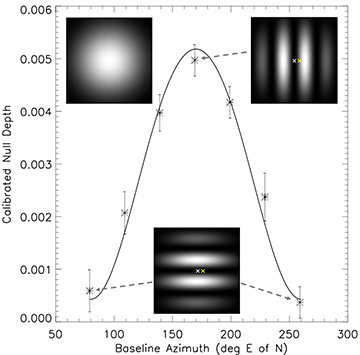 Eta Peg’s measured null-depth rotation curve for a 180° nulling baseline rotation. Top left inset: The full-aperture diffraction beam. Top right inset: At the peak, fringes perpendicular to the binary separation transmit the secondary’s flux. Bottom inset: At the minimum, fringes parallel to the separation extinguish both stars, leaving only residual flux from the larger star’s rim. [Enlarge figure]
Eta Peg’s measured null-depth rotation curve for a 180° nulling baseline rotation. Top left inset: The full-aperture diffraction beam. Top right inset: At the peak, fringes perpendicular to the binary separation transmit the secondary’s flux. Bottom inset: At the minimum, fringes parallel to the separation extinguish both stars, leaving only residual flux from the larger star’s rim. [Enlarge figure]
Exoplanet imaging is very challenging because of the host star’s overwhelming brightness. Even coronagraphic imaging can see only those exoplanets more than about one to three diffraction beamwidths from their host stars, leaving inner planets to be discerned indirectly by radial-velocity or transit observations.
However, nulling interferometry—which destructively interferes starlight arriving at separate collecting apertures—can reach inside the diffraction beam. The idea is to maintain an achromatic null fringe across a star while rotating the interferometer to modulate the fringe transmission on close companions.1 While this was initially thought to require a stable environment in space, we have now demonstrated a ground-based rotating nuller.2
Due to the phase accuracy needed, ground-based nulling had been limited largely to long (mid-infrared) wavelengths,3,4 but by combining several optical techniques, nulling at less noisy near-infrared wavelengths becomes possible. First, the light from a subaperture pair within an image of the pupil of the Palomar Observatory’s Hale telescope was destructively interfered using a dielectric phase shift, the relative phase being maintained by the telescope’s adaptive optics system. To maximize sensitivity to small angles, the diffraction core of the primary star’s nominal point-spread function was coupled to a single-mode optical fiber. However, the anti-phased starlight arrives at the fiber tip with an asymmetric field distribution that cannot propagate,5 leaving only off-axis companion signals. We rotated the fringes inside the stellar diffraction core by rotating the pupil image. Finally, a novel statistical analysis of the residual positive-definite null-depth fluctuations relaxed the phase-accuracy requirement by nearly two orders of magnitude.
Combining these techniques enabled both the detection of the 100-times-fainter secondary star in the spectroscopic binary eta Peg, at a separation of only one-third of the primary star’s diffraction beamwidth, and a simultaneous measurement of the primary star’s diameter, which would usually have required long-baseline interferometry.
We believe that our proof-of-concept demonstration that nulling interferometry can reach several times closer to stars than coronagraphy, though performed on a compact-binary star, is also promising for future exoplanet observations. Realistic null-depth and sensitivity improvements on larger telescopes could enable imaging and spectroscopy of bright exoplanets (such as hot Jupiters and young, self-luminous exoplanets) at the small separations currently accessible only to radial-velocity and transit observations.
Researchers
E. Serabyn and B. Mennesson, Jet Propulsion Laboratory, California Institute of Technology, Pasadena, Calif., USA
References
1. R.N. Bracewell. Nature 274, 780 (1978).
2. E. Serabyn et al. Mon. Not. Royal Astron. Soc. 489, 1291 (2019).
3. P.M. Hinz et al. Nature 395, 251 (1998).
4. M.M. Colavita et al. Publ. Astron. Soc. Pac. 121, 1120 (2009).
5. P. Haguenauer and E. Serabyn. Appl. Opt. 45, 2749 (2006).

